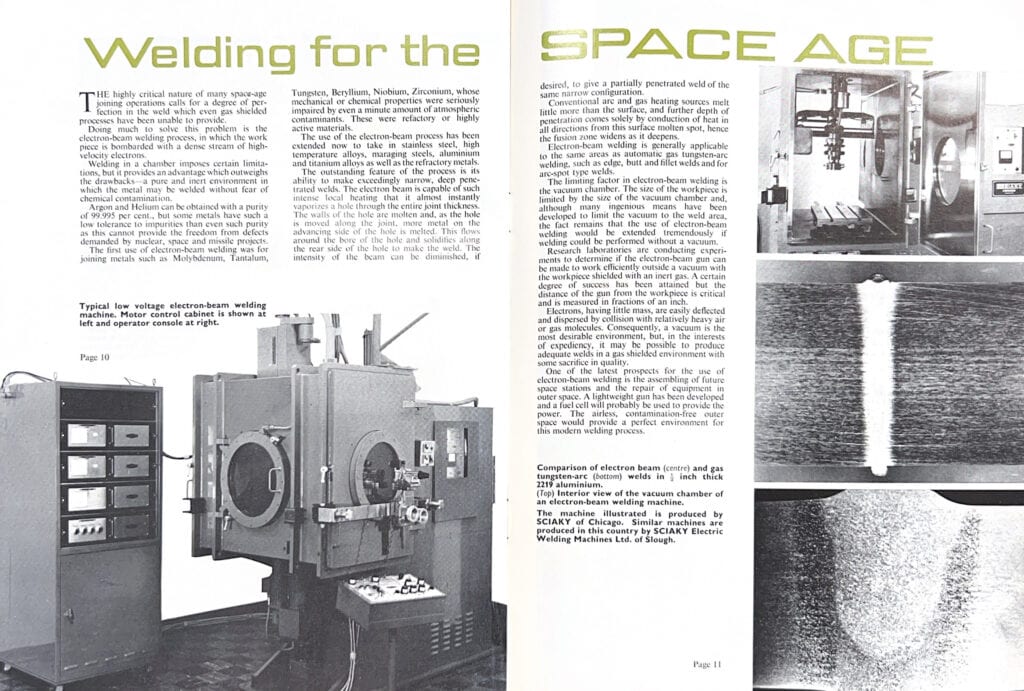Introduction
The dawn of the Space Age brought with it unprecedented challenges in manufacturing and engineering. One of the critical areas demanding innovation was welding, especially for applications in aerospace, defense, and nuclear projects. This case study delves into the revolutionary electron-beam welding process and highlights how Suffolk Iron Foundry (SIF), founded in 1925, played a crucial role in supporting this transformative technology.
The Advent of Electron-Beam Welding
As the world entered the Space Age, the need for highly precise and uncontaminated welding processes became paramount. Traditional welding methods, including gas-shielded processes, often fell short of the perfection required for space-bound and nuclear applications. The electron-beam welding process emerged as a solution, offering unmatched precision and purity by bombarding the workpiece with a dense stream of high-velocity electrons in a vacuum chamber.
Suffolk Iron Foundry’s Crucial Support
While Suffolk Iron Foundry was primarily known for its high-quality cast iron and metallurgical solutions, its involvement in advancing welding technology was significant. SIF provided essential support in the form of specialized components and expertise required for the electron-beam welding machines. This collaboration was instrumental in ensuring the reliability and efficiency of the welding process.
Revolutionizing High-Precision Welding
Electron-beam welding quickly became indispensable for joining materials that were highly sensitive to atmospheric contamination. Metals like Molybdenum, Tantalum, Tungsten, Beryllium, Niobium, and Zirconium, which were crucial for nuclear, space, and missile projects, benefited immensely from this technology.

Key Features of Electron-Beam Welding:
- High Precision: The electron beam creates intense local heating, allowing for narrow, deep penetrated welds.
- Purity: Conducted in a vacuum, the process prevents any chemical contamination, which is critical for high-purity metals.
- Versatility: Initially used for refractory metals, the process was extended to stainless steel, high-temperature alloys, maraging steels, aluminium, and titanium alloys.
Overcoming Challenges with Innovation
One of the main challenges of electron-beam welding was the limitation imposed by the size of the vacuum chamber. The size of the workpiece was restricted by the chamber’s dimensions. To address this, research laboratories, supported by SIF’s technical guidance, conducted experiments to enable electron-beam welding outside a vacuum using inert gas shielding. Though a complete solution was not immediately attainable, significant progress was made, allowing for practical applications in certain scenarios.
Future Prospects: Welding in Outer Space
A notable future prospect for electron-beam welding was its potential use in assembling and repairing equipment in outer space. The vacuum of space provided a perfect environment for this welding method. Suffolk Iron Foundry’s expertise was crucial in developing lightweight, portable welding guns that could be used by astronauts, paving the way for on-site repairs and assembly in space missions.
Case Example: The Sciaky Electron-Beam Welding Machine
A typical low-voltage electron-beam welding machine, such as those produced by Sciaky of Chicago and its subsidiary in Slough, was essential for high-precision welding tasks. These machines, equipped with motor control cabinets and operator consoles, were at the forefront of welding technology. SIF’s contributions ensured that these machines met the rigorous demands of space-age applications.
Conclusion
The story of electron-beam welding is a testament to the power of innovation and collaboration. Suffolk Iron Foundry’s support was pivotal in advancing this technology, ensuring it could meet the stringent requirements of the Space Age. By providing specialized components and expertise, SIF helped revolutionize welding processes, enabling the construction and maintenance of critical aerospace, defense, and nuclear infrastructure.
This case study highlights the importance of expertise and innovation in overcoming technological challenges. As we reflect on the historical advancements in welding technology, it is clear that the combined efforts of pioneers like SIF and leading research institutions have paved the way for modern engineering marvels. The legacy of these collaborations continues to inspire progress in the field of high-precision manufacturing and beyond.
